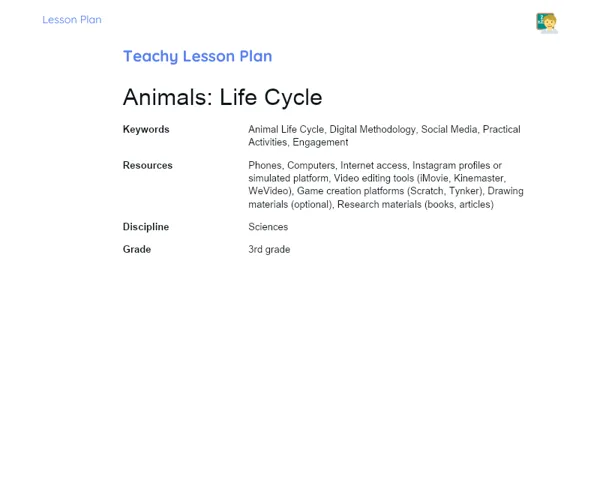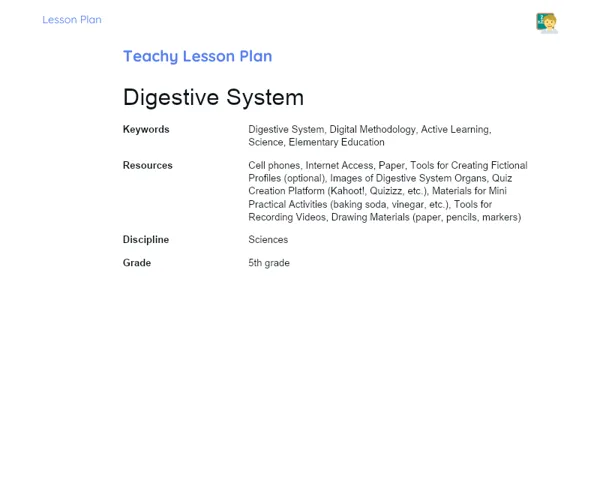Lesson Plan | Socioemotional Learning | Types of Soil
| Keywords | Types of Soil, Science, 3rd Grade, Self-Awareness, Self-Control, Responsible Decision-Making, Social Skills, Social Awareness, RULER Method, Soil Components, Minerals, Organic Matter, Water, Air, Living Organisms, Soil Exploration, Observation, Comparison, Collaboration, Reflection, Emotional Regulation |
| Resources | Soil samples (sand, clay, fertile soil), Magnifying glasses, Small containers of water, Sheets of paper for notes, Pens or pencils, Comfortable chairs, Clock or timer |
| Codes | - |
| Grade | 3rd grade |
| Discipline | Sciences |
Objective
Duration: (10 - 15 minutes)
This stage aims to introduce students to 'Types of Soil,' linking scientific concepts with socio-emotional growth. By piquing students' curiosity about the variety of soils and their significance for plants, the lesson fosters meaningful learning and equips them for upcoming activities that involve recognizing, understanding, naming, expressing, and managing emotions tied to the knowledge they gain.
Objective Utama
1. Recognize different types of soil and their characteristics.
2. Understand the importance of soil for plant growth.
3. Identify the main components of soil.
Introduction
Duration: (15 - 20 minutes)
Emotional Warmup Activity
Deep Breathing for Focus and Presence
The selected emotional warm-up activity is Deep Breathing. It’s a straightforward and effective technique to help students concentrate, unwind, and stay present. Deep Breathing encourages a calm and focused mindset, getting them ready for the lesson in a serene manner.
1. Ask students to sit comfortably in their chairs, feet flat on the ground, and hands resting on their knees.
2. Explain that they will be doing a deep breathing exercise to improve focus and relaxation.
3. Instruct students to close their eyes if they are comfortable and focus on their breathing.
4. Guide them to inhale deeply through their nose, counting slowly to four.
5. Ask them to hold their breath for a brief moment, counting to two.
6. Instruct them to exhale slowly through their mouth, counting to six.
7. Repeat this breathing cycle three to five times, encouraging students to feel relaxation spreading through their bodies.
8. After finishing the breathing cycles, ask students to slowly open their eyes and bring their attention back to the classroom, ready to start learning about different types of soil.
Content Contextualization
Soil is a critical resource for life on our planet. It supports plants, which are at the heart of our food chain, and provides habitat for countless organisms vital to ecosystem health. Just think how tough it would be to grow a garden without good soil! Furthermore, many everyday foods, like fruits and vegetables, rely on healthy soil for strong and nutritious growth.
By diving into the study of various soil types, students are not just learning scientific principles but also enhancing their environmental awareness and sense of social responsibility. Understanding soil's significance allows us to make informed decisions about land use and the conservation of natural resources, which are essential for our future generations.
Development
Duration: (60 - 75 minutes)
Theory Guide
Duration: (15 - 20 minutes)
1. ### Main Components of Soil
2. Minerals: Minerals are tiny fragments of rocks that form the majority of soil. They provide crucial nutrients for plants such as calcium, magnesium, and potassium. Example: Sand, silt, and clay particles are types of minerals found in soil.
3. Organic Matter: This is made up of decomposed plant and animal material. It improves soil structure and enhances its ability to hold water and nutrients. Example: Humus is decomposed organic matter essential for rich soils.
4. Water: Water is vital for plant survival and for the activity of microorganisms in the soil. It dissolves essential nutrients, making them accessible for plants.
5. Air: Air in the soil is necessary for the respiration of plant roots and soil microorganisms. Well-aerated soil supports healthy plant growth.
6. Living Organisms: This includes bacteria, fungi, worms, and insects living in the soil. These organisms help decompose organic matter and recycle nutrients. Example: Earthworms aid in aerating the soil and breaking down organic matter.
Activity with Socioemotional Feedback
Duration: (40 - 45 minutes)
🌱 Exploring and Comparing Soil Types
In this activity, students will examine various soil samples, observing their unique characteristics and comparing them. They will collaborate in groups to identify the components of each soil type and discuss their significance. This exercise promotes responsible decision-making, social interaction, and awareness around soil conservation.
1. Divide the class into small groups of 3-4 students.
2. Provide each group with three different soil samples: sand, clay, and fertile soil (with humus).
3. Distribute magnifying glasses, small water containers, and sheets of paper for note-taking.
4. Instruct students to observe each soil sample with the magnifying glass, noting details about color, texture, and organic content.
5. Ask them to add a little water to each sample and observe how the soaking happens.
6. Encourage the groups to discuss the differences and similarities in their soil samples, focusing on observed features and water retention.
7. Each group should prepare a brief presentation for the entire class, sharing their insights and thoughts on the significance of each type of soil for plants.
Discussion and Group Feedback
To facilitate discussion and socio-emotional feedback, use the RULER method. Recognize students' emotions while they share their findings by reading their facial expressions and body language. Understand the sources of these emotions by discussing their experiences during the activity. Label the emotions accurately, such as excitement, curiosity, or even frustration. Express empathy and encouragement, validating their feelings and promoting the appropriate expression of emotions. Regulate these emotions by fostering a supportive atmosphere where everyone feels at ease sharing their ideas and feelings.
Conclusion
Duration: (10 - 15 minutes)
Reflection and Emotional Regulation
For the reflection and emotional regulation activity, encourage students to write a short paragraph or engage in a group discussion about the challenges they encountered during the lesson and how they managed their emotions. Prompt them to share how they felt while exploring different types of soil, working collaboratively, and presenting their results. Encourage them to pinpoint feelings of frustration, excitement, curiosity, or any other emotions they experienced and contemplate how these feelings affected their learning and interactions with their peers.
Objective: This section aims to foster self-assessment and emotional regulation, aiding students in identifying effective strategies to cope with challenges. By reflecting on their feelings and behaviors, students enhance self-awareness and self-control, which are crucial skills for ongoing learning and socio-emotional development.
Glimpse into the Future
To wrap up the lesson, ask students to set personal and academic goals related to the content covered. Explain that these goals might include researching more about soil types, starting a small gardening project at home or school, or even sharing what they learned with family and friends. Motivate them to think about how they can apply their knowledge in daily life and come up with a plan to achieve these goals.
Penetapan Objective:
1. Research more about soil types and their characteristics.
2. Start a gardening initiative at home or school.
3. Share what they have learned about soil with family and friends.
4. Observe and document various soil types in their local surroundings.
5. Develop a mini-garden at school to apply their knowledge about soil. Objective: This section's objective is to enhance students' autonomy and the practical application of what they have learned, promoting continuous academic and personal growth. Goal-setting helps students stay focused and motivated while fostering a sense of responsibility and commitment to their learning journey. This also builds connections between classroom learning and real-life situations, making knowledge more relevant and impactful.


